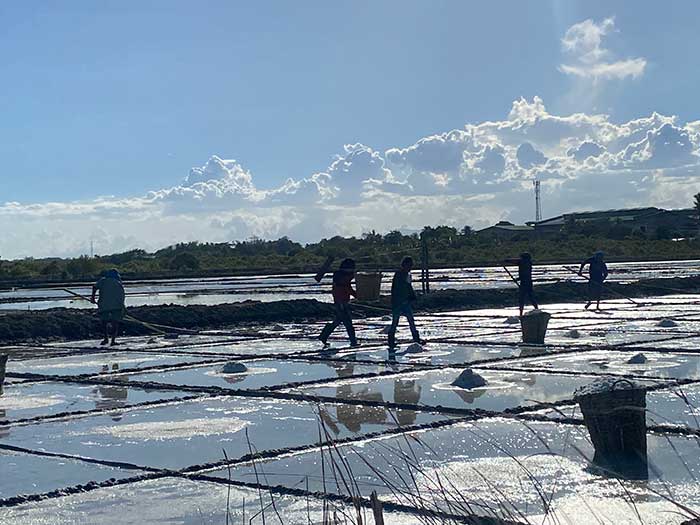Story and photos by Joseph Bernard A. Marzan
It’s 3:30 in the afternoon, and under the sweltering heat of the sun, coupled with the heat from the El Niño phenomenon, a group of men in a small community in Iloilo’s Leganes town till their brick ponds of sea water, gathering what would become salt.
Townsfolk who grew up in Gua-an village, before the paved roads and nearby commercial warehouses, said that the salt-tilling activities have been there for more than 50 years, although no one knows the exact count.
Numerous studies on the salt ponds published online trace back to 1979, coupled with the town’s fishing industry.
Gua-an is one of the four villages in the town known for local salt-making in the region, along with M.V. Hechanova, Napnud, Gua-an, and Nabitasan.
Salt-makers in the town are being supported by the local government and the Bureau of Fisheries and Aquatic Resources through training.
One of them even said that Leganes’ salt fields used to be so vast, but many of them have been effectively wiped out by 2008’s Typhoon Frank.
A recently publicized article in The Philippine Journal of Fisheries has also found that salt-making in Leganes, once considered a regional hub for the product, has actively been under threat from climate change, particularly from changes in rainfall patterns, distribution, and rising sea levels.
Susimo Almario Pudadera Jr., who owns and manages one of the town’s last salt ponds, explained to Daily Guardian that the salt-making process usually takes 10 days before being harvested.
He doesn’t own the land but merely rents it from the owner, who is currently based in Metro Manila.
Seawater is tapped to go into a reservoir and goes through four phases involving filtering and evaporation under the sun, with each phase being done in ‘divisions’ of the land.
The beds are made up of bricks which are held together by clay soil, but there are also separate panels made of polyethylene plastics (PEP).
Both salt beds are being cleaned at the start of the season before they start the production process itself. Cleaning is also being done before the water is allowed into the bed for the next 10 days of production and harvest.
After harvest, these are continued to be dried under the sunlight and the hot air before they are packed into the sacks.
Pudadera says that harvesting on the bricks (or tisa) remains to be more effective in harvesting salt, compared to the PEP beds.
“Tisa is forever. It’s more stable. We’ve been using it since I was little, and what we use has been there for many years. But the plastic easily gets torn over the years because it can be damaged by the salt granules. It’s also not difficult to use. You just have to filter the water,” Pudadera said.
He shared that before they get into the process, they use ‘tubong-tubong’, or their community’s annual way of determining when to start, passed down through generations.
“When it’s sunny on January 1, then we can start in January. [If] on January 2, then we start in February. If January 3, then March. It’s based on the calendar. That’s what was being told to us before,” he explained.
“This year, it was dry from January 1 until January 5, and added with the [forecast] from PAGASA about the El Niño, we found it timely [to harvest salt],” he added.
He estimates that they can harvest around 80 sacks per day, using either old sacks of rice or sugar. He said that it was important to place them in sacks for the convenience of buyers.
Their frequent customers come from Roxas City and northern towns in Iloilo, including Concepcion and Carles, where fisherfolk use them to dry and cure the fish to be sold to markets.
“Customers with [high] volume are from Roxas [City]. The [greatest] volume [of salt being sold] are really to those who dry their fish,” he described.
They also used to supply to ice cream makers, for use in their carts, but these have since stopped because of the emergence of industrial salt being mined from overseas.
“I used to have a client from Dumangas who sells ice cream, who uses their salt on their ice which freezes their tubes, but it looks dirty to their customers. Industrial salt also dissolves slower,” he narrated.
Their biggest competitors are the ‘tultul’ sea salt from Guimaras and the bigger salt producers in Mindoro island.
“Our products here are very small. Mindoro has very nice bricks and very large salt beds,” he said.
The selling rate depends on the volume being sold, with more sacks sold amounting to cheaper prices per sack.
“We sell around P200 to P250 [per sack], depending on the volume. We sell super white [salt] for P400, sometimes P500, depending on who we’re transacting with. When there are less volume sold [to a buyer], it’s more expensive,” he said.
Their income isn’t really definite, but he says they earn enough, usually proportionate to the minimum wage in the region.
“From the beginning, salt has been our source of livelihood, and after that, then farming. I also used to grow bitter gourds to be grounded at the Libertad market in Bacolod and at the [Iloilo Terminal Market] in Iloilo City,” he shared.
After the summer season, they turn to fishing, their other main livelihood, as the rainy season is no longer suitable for harvesting salt.
He said that they don’t know what the future would hold for salt-making in the town, given that property values have gone up since news broke that the planned Panay-Guimaras Bridge would be built in the town.
“If I were the land owner, I would sell [the land]. The salt beds don’t really bring big money, but selling the land would instantly have big money. If you sell an 8-hectare [land] with P5,000 [per area], then you might get up to P4 million. If you manage [a salt bed], how much do you get from that,” he said.




























